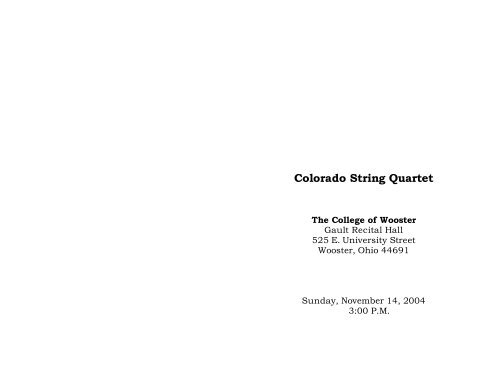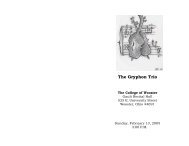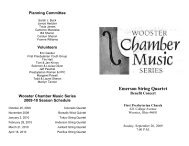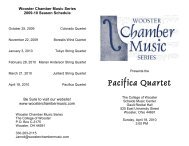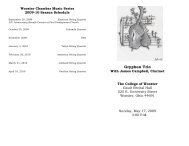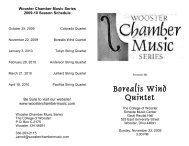colorado - small - Wooster Chamber Music Series
colorado - small - Wooster Chamber Music Series
colorado - small - Wooster Chamber Music Series
Create successful ePaper yourself
Turn your PDF publications into a flip-book with our unique Google optimized e-Paper software.
Colorado String Quartet<br />
The College of <strong>Wooster</strong><br />
Gault Recital Hall<br />
525 E. University Street<br />
<strong>Wooster</strong>, Ohio 44691<br />
Sunday, November 14, 2004<br />
3:00 P.M.
minor. Though it remains true to the conventions of sonata form, it<br />
features a robust developmental section more typical of Beethoven<br />
than Mozart. The Minuet (marked Allegretto) occurs one movement<br />
earlier than was customary at the time. It too is unusually<br />
substantial and dramatic for its time, featuring a Trio section with<br />
considerable chromatic tension.<br />
The Andante flows effortlessly with Classical grace and poise. First<br />
violin and first viola are clearly featured here, so much so that<br />
Charles Rosen describes the movement as “an operatic duet.” The<br />
movement culminates in a brief but an exquisite cadenza weaved by<br />
both instruments. For the Allegro Finale, Mozart crafts a delightful<br />
fusion of contrapuntal writing and elegant melody. The juxtaposition<br />
creates a closing movement that is at the same time irrepressibly<br />
energetic and refined.<br />
Written by Brian Biddle<br />
The Colorado String Quartet<br />
Julie Rosenfeld, Violin<br />
Deborah Redding, Viola<br />
Marka Gustavsson, Viola<br />
Diane Chaplin, Cello<br />
with<br />
Carol Rodland, Viola<br />
The Colorado Quartet is well-known to the <strong>Wooster</strong> audience, having<br />
visited often since first performing here during the early years of the<br />
<strong>Chamber</strong> <strong>Music</strong> <strong>Series</strong>. Audience members have come to appreciate<br />
the group’s lively performances, which are sometimes marked by wit<br />
and always distinguished by passionate and focused playing. The<br />
Colorado Quartet was founded by violinist Deborah Redding at the<br />
University of Colorado twenty years ago, and then moved to The<br />
Juilliard School in New York for training. Ms. Redding is the only<br />
original member who remains with the group. She is joined by Julie<br />
Rosenfeld, violinist, Marka Gustavsson, violist, and Diane Chaplin,<br />
cellist.<br />
The Colorado Quartet has won international acclaim as one of the<br />
finest string quartets, and has toured more than twenty countries on<br />
four continents. They have performed numerous times at Carnegie<br />
Hall and Lincoln Center in New York, as well as the Kennedy Center<br />
in Washington, D.C., and Amsterdam’s Concertgebouw. They<br />
regularly play the complete Beethoven Quartets, and their recent<br />
performances in Berlin made them the first female quartet to have<br />
performed the complete Beethoven cycle in both North America and<br />
Europe. They performed the complete Bartok String Quartets in<br />
Philadelphia, and twenty Haydn Quartets at the Mostly Mozart<br />
Festival in New York. Winners of both the Banff International String<br />
Quartet Competition and the Naumburg <strong>Chamber</strong> <strong>Music</strong> Award, the<br />
Colorado members have also served on the juries of several<br />
international competitions. The Colorado Quartet is Quartet-in-<br />
Residence at Bard College. They teach private lessons, give master<br />
classes throughout North America, and coach chamber ensembles.<br />
The Quartet members’ deep scholarly knowledge of the quartet<br />
literature not only informs their playing, but is also passed on to<br />
future players in the form of courses on the Literature of the String<br />
Quartet at Bard College.<br />
The Colorado Quartet has made critically acclaimed recordings of<br />
works by Beethoven, Schubert, Mendelssohn, and Brahms. Also<br />
noteworthy is their recording of contemporary quartets by Karel<br />
Husa, Ezra Laderman, and Mel Powell. The Colorado worked closely<br />
with all three composers during the production of this CD, which was
ecorded in Sprague Hall at the Yale School of <strong>Music</strong>. They recorded<br />
during late night hours, in a (not always successful) attempt to<br />
lessen the likelihood of noisy interruptions from nearby street traffic.<br />
Another contemporary recording is their “Mosaic <strong>Chamber</strong> <strong>Music</strong> of<br />
Henry Cowell,” recorded in collaboration with the <strong>Music</strong>ians Accord<br />
ensemble.<br />
The Colorado Quartet is joined today by Carol Rodland on viola. Ms.<br />
Rodland made her solo debut with the Philadelphia Orchestra at age<br />
17, and went on to perform throughout North America and Europe.<br />
She has given solo recitals at Merkin Hall and Carnegie’s Weill<br />
Recital Hall, has played concertos with the Stuttgart <strong>Chamber</strong><br />
Orchestra and the Davos Festival Orchestra, has performed as guest<br />
violist with the Henschel Quartet throughout Europe, and has played<br />
frequently with both the Orpheus <strong>Chamber</strong> Orchestra and Vermont’s<br />
Craftsbury <strong>Chamber</strong> Players. Ms. Rodland won first prizes at the<br />
Washington International Competition, the Artists International<br />
Auditions, and the Juilliard Concerto Competition. She has been<br />
professor of viola at the New England Conservatory for two years.<br />
PROGRAM NOTES<br />
Written by Sarah J. Buck<br />
Ludwig van Beethoven (1770-1827)<br />
QUARTET IN A MINOR, OP. 132 (1825) – The monumental last<br />
quartets of Beethoven, the final major works he completed, provide<br />
much insight into the struggle of the composer to remain creatively<br />
active in the midst of the hardships fate had dealt him. In late 1824,<br />
Beethoven began to sketch the A minor quartet, the second of a set of<br />
three commissioned by Prince Galitzin. Work was interrupted,<br />
though, when he was struck with a severe and debilitating abdominal<br />
illness that winter. A period of rest and recuperation in the country<br />
allowed Beethoven to recover, and he was able to finish the work by<br />
July of the following year. The gravity of the sickness clearly left an<br />
impression on the composer; however it is not the pain of the illness<br />
which Beethoven chooses to depict in this piece, but the joy and<br />
thankfulness of his restored health.<br />
The opening of the first movement (Assai sostenuto–Allegro) derives<br />
from the simple, atmospheric landscape of the gentle beginning of the<br />
Ninth Symphony. A solitary rising half step in the cello provides the<br />
seed for a expanding texture in which the other three instruments<br />
quickly join in. As in the Ninth Symphony, though, we are swept<br />
into the movement proper without much delay. Though it proceeds<br />
as a well-behaved sonata-form movement is expected, we are<br />
frequently reminded of the half-step motive from the introductory<br />
passage. Following is a Scherzo (marked Allegro ma non tanto) that is<br />
more relaxed than Beethoven’s typical breakneck pace for such<br />
movements. The Trio section features a lilting melody with a drone<br />
that may remind the listener of a bagpipe tune.<br />
It is in the third movement that we are witness to the emotional<br />
backdrop of the piece. It is prefaced with the inscription Heiliger<br />
Dankgesang eines Genesenden an die Gottheit, in der lydischen Tonart<br />
(Holy song of thanks to God, in Lydian mode). The movement opens<br />
with a sober chorale using the Lydian scale (F major with B-natural<br />
instead of B-flat, using all white notes on the piano). Suddenly,<br />
though, the chorale breaks free, arriving in a spirited D-major<br />
passage. The chorale soon returns in a more rhythmically active<br />
form, again followed by the lively section. The chorale once again<br />
resurfaces. This time, however, it is transfigured, the upper voices<br />
reaching heavenward until the movement gradually fades away.<br />
There is no triumph here, no sense of accomplishment in cheating<br />
fate of its victim. Instead we find a pure statement of thanksgiving<br />
(sometimes prayerful, sometimes ebullient) for the delight of regained<br />
strength.<br />
Beethoven follows this centerpiece movement with a curious march<br />
(marked Assai vivace) whose regimented nature contrasts sharply<br />
with the previous movement. A transition leads us directly into the<br />
Finale, a rondo marked Allegro appasionado. Its straightforward<br />
character may be deliberate; after such trying times there may be<br />
comfort simply in returning to routine. The piece concludes in A<br />
major, confirming the resolution and restoration celebrated<br />
throughout the quartet.<br />
Wolfgang Amadeus Mozart (1756-1791)<br />
QUINTET IN C MAJOR, K. 515 (1787) – Mozart is easily eclipsed in<br />
the canon of Classical-era string quartets by Haydn, the original<br />
master of the genre. Mozart himself illustrated this through the<br />
famous set of six quartets written in homage to his elder<br />
contemporary. Not to be outdone, though, Mozart dabbled in<br />
variations on the traditional quartet instrumentation. For Mozart,<br />
this called for the addition of an extra viola, possibly because it was<br />
his favorite member of the string family (the more common quintet<br />
instrumentation doubled the cello instead). Five original works were<br />
composed for this quintet of two violins, two violas, and cello. The C<br />
major quintet, along with its companion piece (K. 516 in G minor)<br />
were composed in 1787.<br />
The surprisingly expansive opening Allegro commences with a<br />
delightful conversation between cello and violin. The cello begins<br />
with an arpeggiated C major chord, quickly followed by an answer in<br />
the violin. Soon, though, the instruments reverse roles and shift to C
The Colorado String Quartet<br />
Julie Rosenfeld, Violin<br />
Deborah Redding, Viola<br />
Marka Gustavsson, Viola<br />
Diane Chaplin, Cello<br />
Quartet in A minor, Op. 132<br />
Assai sostenuto – Allegro<br />
Allegro ma non tanto<br />
Molto adagio – Andante<br />
Alla marcia, assai vivace<br />
Allegro appassionato<br />
Quintet in C Major, K. 515<br />
Allegro<br />
Menuetto: Allegretto<br />
Molto adagio – Andante<br />
Andante<br />
Allegro<br />
Presented with support of<br />
with<br />
Carol Rodland, Viola<br />
Program<br />
INTERMISSION<br />
BEETHOVEN<br />
MOZART<br />
A very special thanks to<br />
Mrs. Joseph Fishelson for her support.<br />
Kenneth and Nancy Anderson<br />
Bill and Marilyn Blanchard<br />
Mr. and Mrs. David Briggs<br />
Dorothy A. Carlisle<br />
Carlye and Frank Cebul<br />
Joseph Claparols<br />
H. Alberta Colclaser<br />
Ruth and Brian Dykstra<br />
Com-Patt-ibles Floral Elegance<br />
William Dameron<br />
Mary and Ed Eberhart<br />
Mrs. Robert Froelich<br />
Alice and Larry Gabriel<br />
Steve and Liz Glick<br />
Catherine and Tom Graves<br />
R. Stanton and Diane M. Hales<br />
Carolyn Hostetler<br />
UNDERWRITER<br />
Sarah Jane Buck and Nick Amster Fishelson<br />
Mr. and Mrs. Stanley C. Gault<br />
Jay Klemme and Anne Wilson<br />
Lois and Raymond McCall<br />
Stephen M. Rhodes<br />
Vi S. Robertson<br />
Ken and Jill Shafer<br />
Tim and Jenny Smucker<br />
Yvonne and Ted Williams<br />
BENEFACTOR<br />
Marian Cropp<br />
Robert and Mary Grace Engisch<br />
Louise E. Hamel<br />
Elinor B. Hancock<br />
Deborah P. Hilty<br />
Ron and Prue Holtman<br />
Stuart and Terry Ling<br />
Clara Louise Patton<br />
Kathy and Harry Zink<br />
PATRON<br />
SUBSCRIBER<br />
Miriam and Burney Huff<br />
Hal and Roberta Looney<br />
Lyn Loveless<br />
Douglas and Tricia Miller<br />
Sara L. Patton<br />
Kenneth and Louise Plusquellec<br />
Margaret and David L. Powell<br />
Peter C. Pozefsky<br />
Ed E. Schrader and Daniel E. Rider<br />
Steve and Cheryl Shapiro<br />
Bill and Carolyn Sheron<br />
Frances G. Shoolroy<br />
Elena Sokol and Yuri Popov<br />
Marilyn J. Tanner<br />
Donald L.Wilson & Selina Sorrels<br />
Jacquelyn S. Yates<br />
Anonymous<br />
Dr. Martha E. Banks<br />
Mary Finkbeiner<br />
Frank and Jean Knorr<br />
Arun and Rin Masih<br />
Amelia and Cyril Ofori<br />
L. M. Pasho<br />
Clare Adel Schreiber<br />
John and Barb Somogy<br />
Peggy and Charles Ulrich<br />
John and Catherine Wiandt<br />
David Wiesenberg<br />
Josephine Wright


